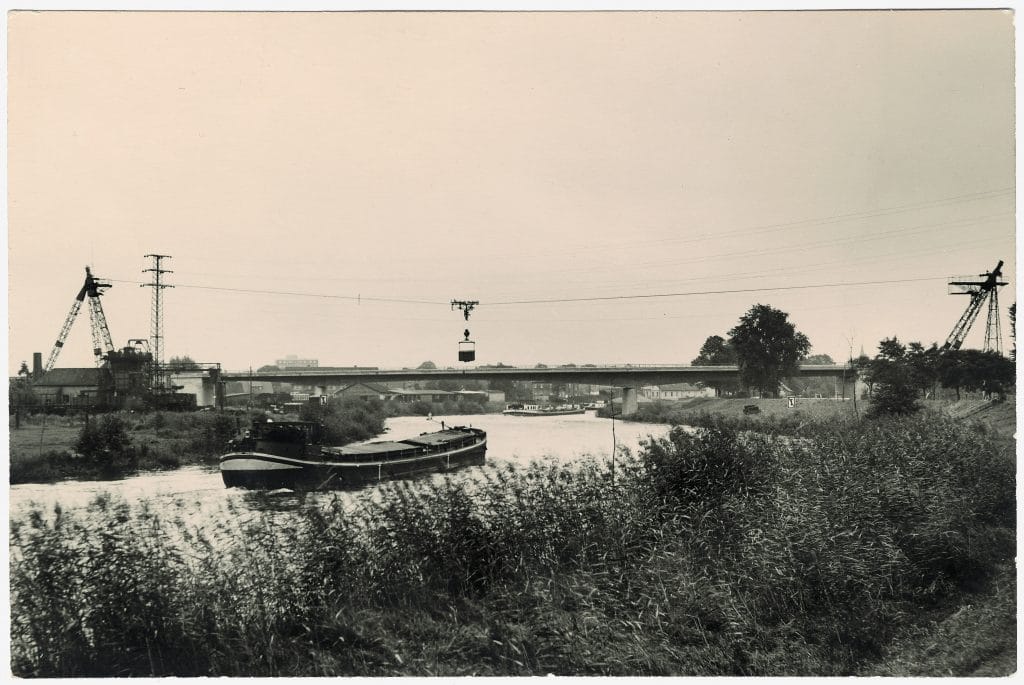95 years on: a cable crane spans the Ems
Join us on a trip down memory lane
In the winter of 1921, a construction called a cable crane was built spanning the river Ems. This created a link between the ‘Heseper Torfwerk’ peat works and the Emshafen inland port in Meppen, which at the time provided the company with a gateway to the world.
After the First World War, the light-railway connection to Meppen was crucial for the peat works in Hesepe if it wished to achieve long-term growth. The expected war reparations made the hoped-for rail link between Meppen and Ter Apel a distant and uncertain prospect. The Emshafen inland port had a rail connection, but goods could also be transhipped here for road or water transport. However, this hub could not be taken advantage of unless the Ems was first crossed …
There was a wooden bridge across the Ems, but this was not stable enough – and too steep – for a light railway. A bridge strong enough for such a railway would have been very expensive: the Ems had to be passable to vessels at all times, yet the river’s regular high water levels would have necessitated a structure at least 15 metres in height. Long ramps would also have been needed for the light railway, as it can tackle only low gradients.
A freight cableway could have provided an alternative, and might have been modelled on that at ‘Torfverwertung Dykerhoff’, a peat plant in the Poggenmoor area near the Lower Saxony town of Neustadt am Rübenberge (between Hanover and Bremen). However, the cableway for Heseper Torfwerk would have had to cover a distance of more than 10 km. The costs entailed – not only of purchase but also of maintenance – rendered it unaffordable.
A cable crane as the most cost-effective solution
Constructing an industrial railway with an alternative means of crossing the Ems was, therefore, the most cost-effective solution to the problem. After the war, Georg Klasmann made a crucial chance discovery at the timber stockyard of a sawmill in Haltern, where a steel cable was stretched right across the yard with a crane trolley running along it. It was able to lift and transport the wood by means of a pulley and a grab.
The solution had thus been found for Heseper Torfwerk: a cable crane would be used to transfer the loaded cars of the industrial railway to the eastern bank of the Ems and to unload the peat products in the Emshafen inland port.
Without further ado, work on building the industrial railway was begun and the contract for the construction of a cable crane awarded. The job went to Cologne-based contractor Pohlig AG, helmed by German engineer Julius Pohlig, which had already created the first public-transport cabin cable-car system as early as 1908 in Hong Kong, as well as the cableway at Sugarloaf Mountain in Rio de Janeiro in 1913, thus gaining worldwide renown.
6.5 cm thick and 155 m in length, the supporting cable of the crane (in Meppen) alone weighed 5.5 t. It was spanned between two 20 m-high cable supports above the Ems in the winter of 1921. A 70 t tension weight ensured that the steel supporting cable constantly remained taut and prevented the cable from being overloaded in the event that an excessive cargo load was attached.
With the change from rail to road forwarding in containers and wagon-carrying trailers via Groß Hesepe and Dalum to Osterbrock station from 1969 onwards, as well as the establishment of loading facilities within the plant itself, the cable crane became superfluous to requirements in 1971. On 31 March 1974 it was dismantled along with the related loading equipment on the river’s eastern bank.
